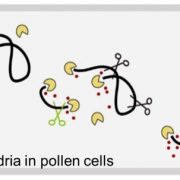
Discovery of mitochondrial endonucleases
Plant Physiology, Plant Physiology: News and ViewsProkaryotic endosymbiont-derived organelles (i.e. mitochondria and chloroplasts), contain their own genomes and the copy number of organelle genomes per cell is high; indeed, a previous study calculated that in Arabidopsis thaliana, each cell has 1000 to 1700 copies of the chloroplast genome (Zoschke…
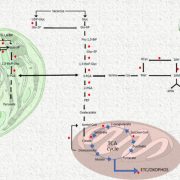
Hydrogen Cyanide Regulation by S-Cyanylation
Plant Physiology, Plant Physiology: On The InsideDespite its toxicity, cyanide has been proposed to act as a regulator of several biological processes such as seed dormancy and germination, resistance to fungal and viral infection. Arabidopsis null mutants of the mitochondrial enzyme β-CYANOALANINE SYNTHASE (CAS-C1) accumulate cyanide to apparently…
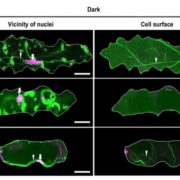
Dark-Induced Nuclear Positioning in Leaf Cells
Plant Physiology, Plant Physiology: On The InsideThe appropriate spatial arrangement of nuclei is essential for various cellular activities during cell division, growth, migration, and differentiation in eukaryotes. In plants, nuclear positioning is also required for proper responses to environmental stimuli, including pathogen infection, touch, temperature,…

New Insights into Carboxysomes
Plant Physiology, Plant Physiology: On The InsideDespite its essential role in photosynthetic carbon fixation, ribulose 1,5 bisphosphate carboxylase/oxygenase (Rubisco) is a relatively inefficient enzyme, due in part to its inability to discriminate between CO2 and O2 as substrates. To suppress the oxygenase reaction and enhance the carboxylase activity…
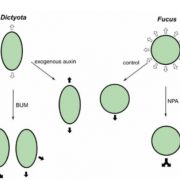
Auxin Function in a Brown Alga
Plant Physiology, Plant Physiology: On The InsideAuxin controls body plan patterning in land plants and it has been proposed to play a similar role in the development of brown algae (Phaeophyta) despite their distant evolutionary relationship with land plants. In flowering plants and many multicellular brown algae, the establishment of the apical-basal…

Plant Reactive Oxygen Species Enhance Virus Spread by Aphids
Plant Physiology, Plant Physiology: On The InsideHemipterans, a group of phloem-feeding insects that includes aphids, planthoppers, and whiteflies, are responsible for the spread of most plant viruses from plant to plant. Stylet positioning and feeding activities have important consequences for the acquisition and transmission of viruses by insect…
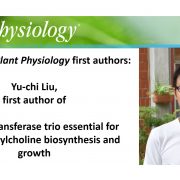
Recognizing Plant Physiology first authors: Yu-chi Liu
Plant Physiology, Plant Physiology: Author ProfilesYu-chi Liu, first author of A methyltransferase trio essential for phosphatidylcholine biosynthesis and growth
Current Position: Technical specialist, Institute of Plant and Microbial Biology, Academia Sinica, Taipei, Taiwan
Education: BS in Bioengineering, Tatung University, Taiwan. MS in Life…

Recognizing Plant Physiology first authors: Guanxiao Chang
Plant Physiology, Plant Physiology: Author ProfilesGuanxiao Chang, first author of ABI5-BINDING PROTEIN 2 Coordinates CONSTANS to Delay Flowering by Recruiting the Transcriptional Corepressor TPR2
Current position, Postdoctoral Researcher, Key Laboratory of Plant Stress Biology, State Key Laboratory of Cotton Biology, School of Life Sciences, Henan…

Recognizing Plant Physiology first authors: Evan McConnell
Plant Physiology, Plant Physiology: Author ProfilesEvan McConnell, first author of Proteome-wide analysis of cysteine reactivity during the effector-triggered immunity
Current Position: Ph.D. Student in Chemistry, University of North Carolina at Chapel Hill, Chapel Hill, NC, USA
Education: B.S. in Chemistry (2014), University of Alabama, Tuscaloosa,…

